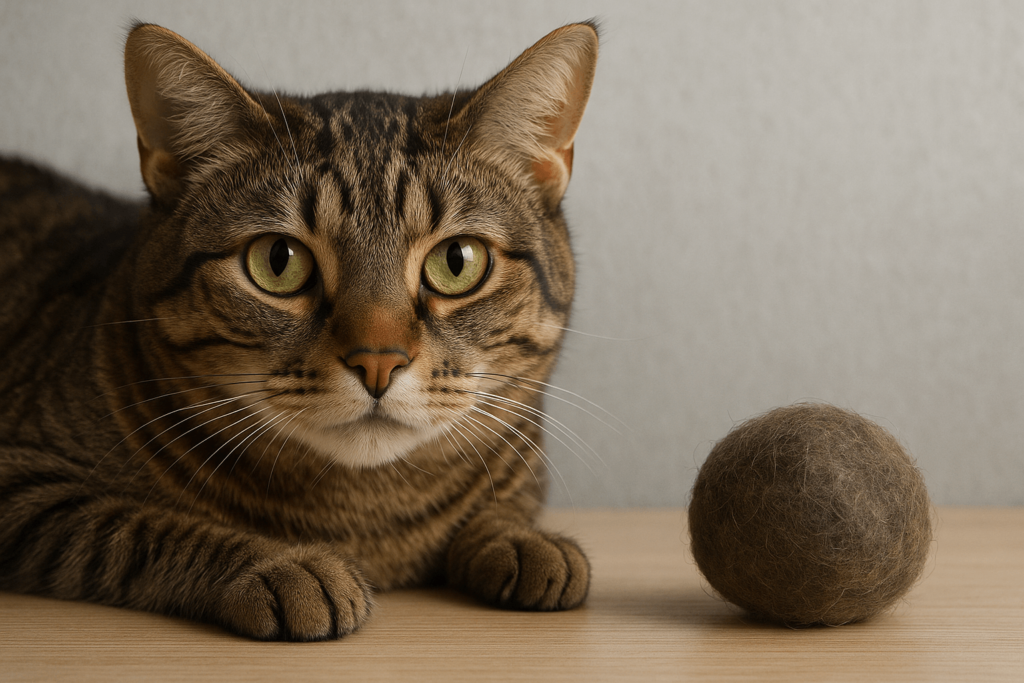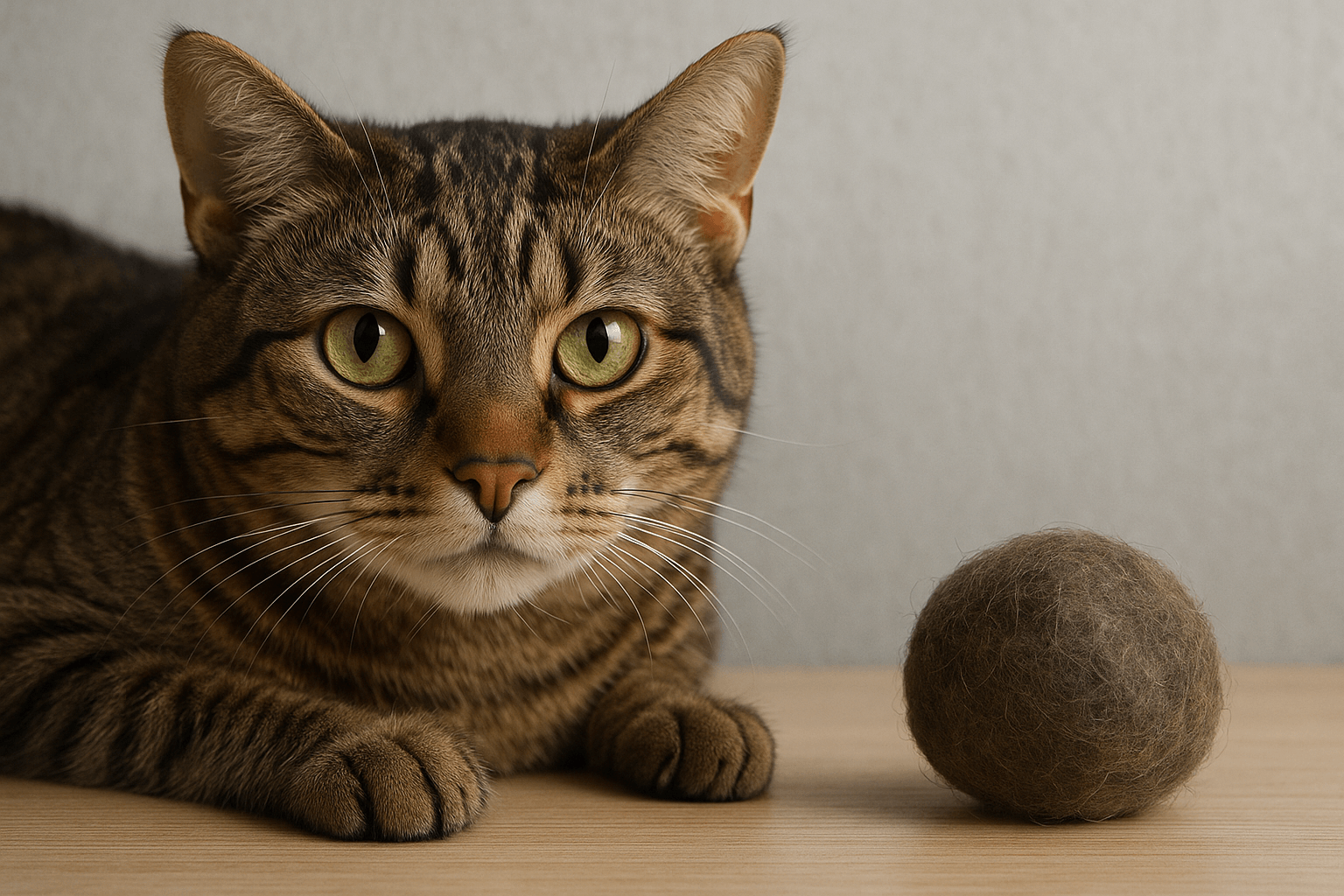Trichobezoar in Cats: The Hidden Danger Behind Every Hairball
Cats groom themselves relentlessly—licking, nibbling, smoothing their fur with a tongue like sandpaper. It’s natural. It’s soothing. But beneath that ritual lies a silent threat: the trichobezoar. A trichobezoar isn’t just a hairball you find on the rug. It’s a dense, tangled mass of ingested fur that can grow inside your cat’s stomach… and become life-threatening. Most owners dismiss hairballs as harmless quirks. But when grooming goes too far—or digestion falters—what starts as a few swallowed hairs can turn into a medical emergency. Understanding trichobezoars isn’t about fear. It’s about awareness. This guide reveals what they are, why they form, how to spot them early, and how to protect your cat before it’s too late.
What Exactly Is a Trichobezoar?
A trichobezoar is not a simple hairball. It’s a pathological accumulation of hair that has failed to pass naturally through the digestive tract. Unlike the occasional vomited hairball, a trichobezoar can grow large enough to cause obstruction, pain, and even organ damage.
It’s a Dense Fiber Mass:
Formed from swallowed fur that clings together due to stomach mucus, creating a felt-like ball that resists breakdown.It Develops Over Time:
Not overnight. It’s the slow, silent buildup from daily grooming, especially in long-haired breeds or cats with excessive licking.It’s Often Misdiagnosed:
Many owners assume vomiting hairballs is normal, missing the warning signs that a true trichobezoar is forming.It Can Extend Into the Intestines:
In severe cases, the mass travels beyond the stomach into the small intestine—a condition called “Rapunzel syndrome” in humans, and just as dangerous in cats.It’s Not Always Vomited:
Many trichobezoars never exit the body naturally. They remain hidden, growing until they cause systemic illness.
A trichobezoar is not a grooming mishap—it’s a digestive failure. Ignoring it is like ignoring a slow leak in your car’s radiator. The damage accumulates before the engine fails.

Why Do Cats Swallow So Much Hair?
Cats don’t swallow fur by accident. It’s an unavoidable consequence of their grooming instinct. But some cats ingest far more than others—and here’s why:
Long-Haired Breeds Are at Higher Risk:
Persians, Maine Coons, and Ragdolls shed more, and their longer hairs tangle more easily in the stomach.Excessive Grooming (Psychogenic Alopecia):
Stress, anxiety, or boredom can drive cats to lick obsessively, ingesting dangerous amounts of fur.Poor Digestive Health:
Slow motility, inflammatory bowel disease, or food intolerances prevent hair from moving through the GI tract efficiently.Lack of Fiber in Diet:
Fiber helps sweep hair along. Low-fiber diets leave hair stranded, increasing clumping risk.Skin Conditions or Parasites:
Itchy skin from fleas, allergies, or infections causes cats to lick more, swallowing more hair as a coping mechanism.
The problem isn’t the hair—it’s the volume and the body’s inability to process it. When grooming becomes compulsive or digestion becomes sluggish, the system overloads.
Check this guide 👉Acetaminophen Toxicity in Cats: Best 7 Expert Tips!
Check this guide 👉Polycystic Kidney Disease in Cats: Best 7 Expert Tips!
Check this guide 👉Acute Kidney Failure in Cats: Best 7 Expert Tips!
| Risk Factors for Trichobezoar | Why It Matters |
|---|---|
| Long or thick fur | More hair ingested per grooming session increases mass buildup. |
| Chronic stress or anxiety | Compulsive licking leads to rapid, excessive hair ingestion. |
| Age (senior cats) | Slower digestion and reduced mobility make hair passage harder. |
| Poor diet low in fiber | Lack of bulk slows GI transit, allowing hair to clump. |
| Underlying medical conditions | IBD, constipation, or thyroid disease impair normal motility. |
Signs Your Cat May Have a Trichobezoar (Beyond the Hairball)
Most cats vomit a hairball once every few weeks. That’s normal. But if your cat shows these signs, it’s not a hairball—it’s a trichobezoar.
Frequent Vomiting Without Visible Hair:
If your cat retches daily but produces little to no fur, the mass may be lodged too far down to expel.Loss of Appetite or Picky Eating:
A trichobezoar presses on the stomach, making eating uncomfortable or even painful.Lethargy and Hiding Behavior:
Cats in abdominal pain often withdraw, sleep more, and avoid interaction.Constipation or Straining to Poop:
Hair can obstruct the intestines, causing fecal backup, dry stools, or complete blockage.Abdominal Distension or Tenderness:
If you gently press on your cat’s belly and they flinch, cry, or pull away—this is a red flag.
These aren’t minor inconveniences. They’re symptoms of internal distress. A trichobezoar doesn’t always cause vomiting—it causes suffering.
How Veterinarians Diagnose a Trichobezoar
You can’t see a trichobezoar with the naked eye. Diagnosis requires professional tools and careful observation.
Physical Examination:
Vets palpate the abdomen for firm, movable masses—often felt near the stomach or upper intestines.X-Rays:
While hair is radiolucent, a large trichobezoar may appear as a dense, irregular opacity with gas pockets around it.Ultrasound:
The gold standard. Ultrasound reveals the texture, location, and size of the hair mass with high accuracy.Bloodwork and Fecal Tests:
Rule out other causes like kidney disease, infection, or parasites that mimic trichobezoar symptoms.Endoscopy (if needed):
A tiny camera is inserted through the mouth to visually confirm the mass—and sometimes remove small ones non-surgically.
Don’t wait for your cat to collapse. If vomiting persists beyond occasional episodes, insist on imaging. Early detection saves lives—and surgery.
Treatment Options for Trichobezoars
Treatment depends on severity. Some cases can be managed conservatively. Others require emergency intervention.
Laxatives and Hairball Remedies:
Lubricants like petroleum jelly-based gels can help move small masses—but they won’t dissolve large ones.High-Fiber Diets:
Prescription diets rich in insoluble fiber (like pumpkin or psyllium) help sweep hair along naturally.Increased Hydration:
Wet food and water fountains improve GI motility and soften the mass for easier passage.Manual Removal via Endoscopy:
For moderate cases, vets can use a scope to extract the mass through the esophagus—no incision needed.Surgical Removal (Laparotomy):
Required when the trichobezoar is large, hard, or causing intestinal obstruction. Recovery takes days to weeks.
Surgery isn’t a failure—it’s a rescue. Cats recover well when treated promptly. Delaying treatment risks perforation, sepsis, or death.
Preventing Trichobezoars Before They Form
Prevention is always better than cure. Here’s how to stop a trichobezoar before it begins.
Daily Brushing:
Brush long-haired cats daily. Short-haired cats benefit from 2–3 brushes per week. Remove loose fur before it’s swallowed.Use a Deshedding Tool:
Tools like the Furminator or slicker brushes remove undercoat efficiently, reducing ingestion.Feed Hairball-Control Food:
Formulated with increased fiber and lubricants, these diets help move hair through the system.Provide Mental Stimulation:
Boredom leads to over-grooming. Use puzzle feeders, laser toys, and window perches to reduce stress licking.Schedule Regular Vet Checkups:
Annual bloodwork and physical exams catch early signs of digestive issues or skin conditions that trigger excessive grooming.
A little time spent brushing today prevents a hospital bill—and trauma—tomorrow.
Why Some Cats Are More Prone Than Others
Not all cats are equal when it comes to trichobezoar risk. Genetics, environment, and health all play a role.
Breed Predisposition:
Long-haired breeds like Persians, Himalayans, and Norwegian Forest Cats are at highest risk due to dense undercoats.Indoor Lifestyle:
Cats with no outdoor stimulation often develop compulsive grooming habits from boredom or anxiety.Seasonal Shedding:
Spring and fall bring massive shedding. Without extra brushing, hair ingestion spikes dramatically.Multi-Cat Households:
Competition or tension can increase stress-related grooming in one or more cats.Previous GI Issues:
Cats with a history of constipation, IBD, or slow motility are more likely to develop persistent hair masses.
Know your cat’s profile. If they’re a long-haired indoor Persian with anxiety and a low-fiber diet—you’re playing with fire. Mitigate the risks before they ignite.
FAQ: Trichobezoar in Cats
Can a trichobezoar dissolve on its own?
Rarely. Small masses may pass with laxatives and fiber, but large, hardened trichobezoars rarely dissolve without intervention.
Is vomiting hairballs every week normal?
No. Once every 2–4 weeks is typical. Weekly vomiting suggests excessive ingestion or poor motility—consult your vet.
Can I give my cat olive oil to help pass hair?
Not recommended. Olive oil can cause diarrhea or pancreatitis. Use vet-approved hairball remedies instead.
Do hairball treats work?
They can help mildly, but they’re not a cure. Many are high in calories and low in fiber. Use them as supplements, not solutions.
Will spaying or neutering reduce over-grooming?
Sometimes. If stress-related grooming is tied to hormonal anxiety, neutering may help. But it won’t fix boredom or medical causes.
Respect the Grooming Ritual—But Don’t Ignore the Warning Signs
Grooming is poetry in motion. The quiet flick of a tongue, the rhythmic licks, the serene focus—it’s part of what makes cats so deeply captivating. But beneath that beauty lies a silent danger. A trichobezoar doesn’t announce itself with a cry. It whispers—through a dull coat, a missed meal, a tired gaze.
You don’t need to stop your cat from grooming.
You need to support their body in handling what they naturally ingest.
Canned Pumpkin for Cat Diarrhea: Best 7 Expert Tips! Natural remedy to firm stools, soothe upset bellies, and support gut health safely.
Can a Cat Give You Scabies? Best 7 Expert Tips! Discover the truth about feline mites, human skin risks, and how to protect yourself—without panic.
Cat Flea vs Human Flea: Best 7 Expert Tips! Discover the truth about bites, species, and how to eliminate infestations for good.
Weird Cat Behaviors: Best 7 Expert Tips! Discover why cats do strange things—and how to understand, not punish, their instincts for a happier home.





